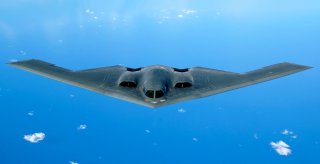Russia Has its Sights Set on a New Stealth Bomber
If Russian military history can teach us anything, the Tu-22M, -95, and -160 will probably be maintained and upgraded for many years to come.
Here's What You Need to Remember: This would be the first truly Russian bomber—not simply a legacy Soviet design, or improvements upon them.
Most military equipment in Russian arsenals today is legacy Soviet hardware. Russian bombers are no exception. Although some airframes in Russian inventories are quite old, they remain potent thanks to airframe, electronics and radar upgrades, along with improvements in standoff missiles and precision-guided munitions. Here are Russia’s most dangerous bombers.
Tu-95 “Bear”
In 1950, Andrei Tupolev was tasked with designing the Soviet Union’s new long-range heavy bomber, the Tu-95. It was to be able to carry a 24,200-pound payload with a range of nearly 5,000 miles—and thus threaten important targets in the United States.
Tupolev needed to balance speed and performance with range. Jet engines at the time would given a long-range strategic bomber the needed speed, but guzzled fuel, limiting range. Although Tupolev was already a highly successful designer, he tasked a group of German and Austrian aircraft engineers that had been captured after World War II with the design. They designed the most powerful turboprop engine ever made, the venerable KN-12.
Using two sets of contra-rotating propellers, the KN-12 is still used on the Tu-95 today. Although the engines are extremely powerful, the are also incredibly loud. Still, when mission requirements are massive payload rather than stealthiness, the Bear can do the job.
Repeated upgrades have greatly extended the airframe’s service life, and increasingly sophisticated stand-off cruise missiles have kept the Tu-95 potent. It is planned to operate until the 2040s.
Tu-22M “Backfire”
Sometimes called “Backfire” by NATO, the Tu-22M variant was developed to address design deficiencies inherent in the Tu-22 parent design. The Tu-22M uses a variable-sweep wing design that provided a balance between favorable landing and take-off handling, with good cruising and high-speed flight.
The Tu-22M carries a respectable bomb load, and can fly at a maximum speed of Mach 1.88. Interestingly, it has a twin-barreled 23mm cannon in the tail that is remotely controlled.
The introduction of the Tu-22M in the early 1970s was an odd time for supersonic bombers, as the superiority of ICBMs was widely recognized. Despite the Tu-22M’s technical obsolescence, continuous upgrades to radar and electronics, combined with improved air-to-surface missiles have kept the Tu-22M platform relevant.
Tu-160 “Blackjack”
The Tu-160 is truly a beast of an aircraft with several firsts and world records to its name. Visually similar to the Tu-22M or the American Rockwell B-1 Lancer, the Tu-160 was the last strategic bomber designed by the Soviet Union.
Also known as the “Blackjack” it is the heaviest bomber in service in any country, and tops out at Mach 2.05. In contrast to the B-1 Lancer, the Blackjack is more of a stand-off weapons platform rather than a traditional bomber, although its tow large weapons bays allow it to carry a payload of 88,000 pounds and allows the delivery of conventional, precision, and nuclear munitions. The Blackjack is the only Soviet bomber designed without any defensive weapons.
Again, upgrades to radar and targeting, along with the restart of airframe production in 2019 is keeping the Blackjack airborne, probably for many more years to come.
Tupolev PAK DA
Although still under development, the PAK DA will undoubtedly be Russia’s deadliest bomber. Once fielded, the PAK DA will eventually replace both the Tu-160 supersonic bomber and the earlier Tu-95.
PAK DA is essentially a next-gen long-range stealth bomber, similar to the Northrop Grumman B-2 Spirit bomber. Like the B-2, the PAK DA will probably have a flying wing design, although this is only known from promotional material. No known prototypes currently exist. This would be the first truly Russian bomber—not simply a legacy Soviet design, or improvements upon them.
The first PAK DA prototype flight was delayed from 2019 to sometime in the 2021–2023 timeframe. As already pointed out, upgraded variants of the Tu-160 are currently conducting flight trials, so it will likely be some time before we have any photos or more concrete info on Russia’s first true stealth bomber.
Future Flight
If Russian military history can teach us anything, the Tu-22M, -95 and -160 will probably be maintained and upgraded for many years to come. When and if the PAK DA becomes operational, it would put an important arrow in Russia’s quiver—a theoretically very capable stealth bomber. Still, if that can be managed affordably remains to be seen. The relatively low price of oil has severely constrained Russian military spending, and designing a brand-new stealth platform is no easy thing.
Caleb Larson holds a Master of Public Policy degree from the Willy Brandt School of Public Policy. He lives in Berlin and writes on U.S. and Russian foreign and defense policy, German politics, and culture. This article is being republished due to reader interest.
Image: Wikimedia Commons.

